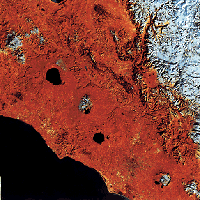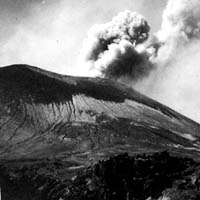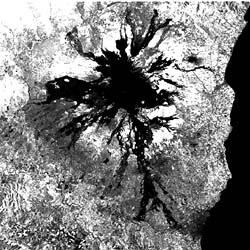 |
|---|
| Plate V-16 |
 |
|---|
| Plate V-16 |
Volcanism in Europe during historic times has occurred in France, Germany, Greece (Santorini Island), and Italy (Rittman, 1973). Central Mediterranean volcanism is concentrated in a zone along the west coast of the Italian peninsula, through the Aeolian Islands (Stromboli, Vulcano), and at Mt. Etna in eastern Sicily (Barberi et al., 1973). This activity expresses continuing interaction between the eastward-moving Ligurian microplate and the Adriatic microplate, which contains the Apennines, that involves migration of an arc-subduction zone resulting from late stage shifts in Cenozoic alpine deformation. As evident in a Landsat subscene of central Italy ( Figure V-16.1; Rome near bottom), lake-filled calderas mark a line of now extinct volcanoes (Monte Albani, Sabatini, Cimini, Vulsini, and Amiata) that spewed forth potash-rich lavas (leucite- and nepheline-bearing (Alvarez, 1975)); similar volcanic products characterize Vesuvius to the south. These and the Aeolian Island volcanoes release sialic magmas contaminated by continental crust rocks. Etna's lavas come from deep sources in the upper mantle, as evidenced by their low Sr87/Sr86 ratios (Tangay and Kieffer, 1976-77).
Mount Etna, Europe's largest active volcano, stands in sharp contrast to the surrounding sedimentary units in northeast Sicily. Most Sicilian rocks are Mesozoic or Cenozoic in age, with limestones and shales dominant, many being flysch deposits. The present island was once simultaneously connected with the Atlas and Barbery chains of North America and the Apennines to the north. Now detached from the African Berberides, Sicily is part of the Tyrrhenian arc that remains structurally higher than the present Tyrrhenian marine basin. From Oligocene to Miocene, as the Alpine orogeny culminated, thrusting affected much of Sicily. Etna itself is built on a horst that utilized northeast fracture lines extending across the Strait of Messina.
| Figure V-16.1 | Figure V-16.2 |
|---|---|
 |
 |
Etna's base extends 40 km east-west and nearly 60 km north-south. Lavas from its many eruptions (average of 15 per century) cover nearly 1000 km2. These lavas are described as andesitic basalts, with trachyandesites, tephrites, phonolitic tephrites, mugearites, and hawaiites as differentiates produced in fissures owing to variations in rates of ascent. The Etna eruptions can be classed into three types: (1) subterminal effusion, taking place at the central cone vent (Figure V-16.2) (after degassing, the lavas outflow quietly without building any structure), (2) lateral eruption, involving simultaneous venting of ash at the central cone and eruption along the volcano flanks as lavas escape through a radial fissure (a row of cinder cones lines the fissure intersection with the surface), and (3) eccentric eruption, controlled by a separate noncentral vent that breaks out on the flank and constructs parasitic cones (Walker, 1968). Lavas predominate on the lower slopes, with pyroclastics more in evidence near the summit (Figure V-16.3).
This Plate shows a 1983 eruption in progress. Comparison of flow patterns around Etna in this Plate with a Landsat view taken in 1977 (Figure V-16.4) reveals the location and shape of the new 1983 lava flow and the 1981 eruption to the north.
| Figure V-16.3 | Figure V-16.4 |
|---|---|
 |
 |
The extensive dark areas seen in these images are Etna's young lava flows, mostly those extruded since about 1150 A.D. Although the majority originate from vents high on the flanks, a few, notably that of 1669 which flowed through the town of Catania and partially filled its harbor, escape from lower flank fissures. Lavas entering low-lying ground tend to disappear under vegetation cover. In marked contrast to 19th and 20th century flows, those of 1651 and 1566 (A.D.) flow on the northeast flank, the 1537? flow on the northwest, the 1591 flow on the west, and the 1169 flow on the southwest are almost totally vegetated. The lower slopes of Etna are densely populated; the highest villages, forming an incomplete ring around the flanks, are localized by the upper limit of available water. On the average, about three flows per century reach the populated areas and cause damage. This has happened five times during this century-in 1923, 1928, 1947, 1971, and 1982. One of Etna's lavas is said to have blocked Hannibal's army in Roman times.
Etna had a profound influence on scientific belief in Renaissance times and was important in the development of understanding volcanism in the early days of modern geology. In the early l9th century, Charles Lyell observed that the historic lava flows, although extensive, were but a thin veneer on the great bulk of the volcano, and that few of the 150-odd cinder cones such as Monte Rossi were known to have been produced by historic eruptions. These observations demonstrated to Lyell that Etna, though very young in relation to the geologic record, must be very old in relation to recorded history, thus laying the foundations for our present ideas on the immensity of geologic time. Text modified from comments by G. P. L. Walker. Landsat, April 23,1983.
Continue to Plate V-17| Chapter 3 Table of Contents.| Return to Home Page| Complete Table of Contents